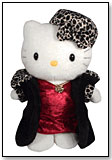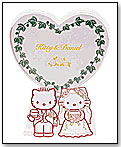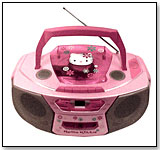 |
Designer
profile
Designing an Icon: Hello Kitty Transcends Generational and Cultural
Limits
By Tina
Dhamija
April 1, 2003

Hello
Kitty Plush |
In
the history of licensed products, perhaps no one foreign-born company
has managed to reach as many hearts as Japan’s Sanrio Company
and its popular mascot, Hello Kitty. Although consumers in the United
States may not consider Hello Kitty and Friends a product line fit
for anyone over 12 years old, in her native Japan, Hello Kitty is
considered a cultural standard of caring.
Gift baskets stuffed with Sanrio products make their way to the
gift tables of weddings and graduations alike, and the same high
regard for Sanrio products has been spreading its fingers across
the US market as well. Last year Americans spent $300 million on
Sanrio products and its colorful cast of characters.
Founded in 1960 by President and CEO Shintaro Tsuji, Sanrio began
with the concept that “A small gift can bring a big smile
to a child of any age.” Since then, Sanrio has grown from
a small stationery and gift business, to a worldwide corporation
manufacturing everything from plush toys, candy, stationery and
even cosmetics.
Consumers can experience Sanrio on every level and may even exchange
wedding vows at the Sanrio Puroland all indoor theme park, located
in Tama city, Tokyo.
 Hello
Kitty Wedding Frame
Hello
Kitty Wedding Frame |
ToyDirectory
tracked down Sanrio product designer, Donna Suzuki of Sanrio’s
San Francisco office, to find out what it takes to bring Hello Kitty
and Friends from the drawing board to the shelves.
ToyDirectory (TD): How long have you been working
as a designer with Sanrio?
Donna Suzuki (DS): I’ve been with Sanrio
for 13.5 years.
TD: From where do you pull your inspiration for
your designs?
DS: Inspiration comes from many different areas.
Fashion trends; product trends; design, illustration, youth, street,
teen and pop culture.
TD: How would we, if possible, be able to tell
if you designed a certain line of Sanrio characters? Are there any
trademark details that it was you that designed a product?
DS: You wouldn't be able to tell if a certain designer
created a certain line. Everything is created with the Character
in mind.
TD: Would you happen to know how the first Hello
Kitty design came out, and by whom it was fashioned?
 Hello
Kitty Boom Box
Hello
Kitty Boom Box |
DS:
Ikuko Shimizu was the original designer of Hello Kitty. The first
product came out in 1974 in Japan and 1976 in the USA.
TD: Certainly, you may have noticed that in the
past 5 to 10 years or so, Hello Kitty has become increasingly popular
with both older and younger people in the US. What does this tell
you as a designer and how do you design to meet the demands of today's
market?
DS: What it tells us is that Hello Kitty is timeless.
The kids that loved her as kids are now adults and the love for
her is still in their hearts. As they become mothers they introduce
their little ones to Hello Kitty and the cycle begins again. As
a designer we have to keep in tune to the different needs of the
age targets. Our designs for the younger target are applied to products
for that age group. As we design for the teen or adult market the
focus on practical and fashionable items come to mind.
TD: How does designing Kitty for the US market
differ from the designs made for Hello Kitty in her native Japan?
DS: The difference in designs is subtle. Usually
what sells in Japan will sell here too except for products that
don't apply. For the US we design based on our consumers and trends.
TD: About how many new designs does Sanrio come
out with per month, and out
of those how many make it to the drawing board?
DS: We do not have a lot of design submissions
per month. Usually, we design promotions such as everyday, seasonal,
product-driven items, etc. that add up to about 100 new items released
every month, including products designed in Japan.
TD: What types of items do you usually design?
Is it mainly plush and dolls, or stationery, or is it a little bit
of everything?
DS: When we create a design promotion it is usually
around 20-30 items--sometimes more, sometimes less, depending
on the promotion. Within this group we select products suitable
to the age target and promotion, whether it was seasonal or not.
So I would say it's a little bit of everything.
TD: How has designing for a hugely successful company
like Sanrio changed your life as a designer? Has it always been
a dream of yours, and do you consider Hello Kitty a part of who
you are?
DS: My life as a designer hasn't changed much,
just the focus. I'm more in tuned to the retail market, fashion
and trends. My world is the "pinkest" it's ever been since
working here and it's great. Hello Kitty exists as part of my daily
life and always will be a part of me.
|
 |
